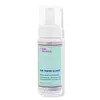What's inside
What's inside
 Key Ingredients
Key Ingredients

 Benefits
Benefits

 Concerns
Concerns

 Ingredients Side-by-side
Ingredients Side-by-side

Water
Skin ConditioningSodium Lauroyl Oat Amino Acids
CleansingBetaine
HumectantDisodium Cocoyl Glutamate
CleansingSodium Cocoyl Glutamate
CleansingPEG-60 Almond Glycerides
EmulsifyingCalophyllum Inophyllum Seed Oil
AntimicrobialPhyllanthus Emblica Fruit Extract
HumectantBoswellia Serrata Extract
Skin ConditioningSerenoa Serrulata Fruit Extract
Skin ConditioningCaffeine
Skin ConditioningSodium Coco Pg-Dimonium Chloride Phosphate
CleansingSalicylic Acid
MaskingParfum
MaskingCitral
PerfumingAlcohol Denat.
AntimicrobialPotassium Sorbate
PreservativeSodium Gluconate
Skin ConditioningPhenoxyethanol
PreservativeWater, Sodium Lauroyl Oat Amino Acids, Betaine, Disodium Cocoyl Glutamate, Sodium Cocoyl Glutamate, PEG-60 Almond Glycerides, Calophyllum Inophyllum Seed Oil, Phyllanthus Emblica Fruit Extract, Boswellia Serrata Extract, Serenoa Serrulata Fruit Extract, Caffeine, Sodium Coco Pg-Dimonium Chloride Phosphate, Salicylic Acid, Parfum, Citral, Alcohol Denat., Potassium Sorbate, Sodium Gluconate, Phenoxyethanol
Ingredients Explained
These ingredients are found in both products.
Ingredients higher up in an ingredient list are typically present in a larger amount.
Potassium Sorbate is a preservative used to prevent yeast and mold in products. It is commonly found in both cosmetic and food products.
This ingredient comes from potassium salt derived from sorbic acid. Sorbic acid is a natural antibiotic and effective against fungus.
Both potassium sorbate and sorbic acid can be found in baked goods, cheeses, dried meats, dried fruit, ice cream, pickles, wine, yogurt, and more.
You'll often find this ingredient used with other preservatives.
Learn more about Potassium SorbateSalicylic Acid (also known as beta hydroxy acid or BHA) is a well-known ingredient for treating skin that struggles with acne and clogged pores. It exfoliates both the skin's surface and deep within the pores to help clear out buildup, control oil, and reduce inflammation.
Unlike AHAs (alpha hydroxy acids), salicylic acid is oil-soluble. This allows it to penetrate into pores which makes it especially effective for treating blackheads and preventing future breakouts.
Salicylic acid is also known for its soothing properties. It has a similar structure to aspirin and can calm inflamed or irritated skin, making it a good option for acne-prone skin that is also sensitive.
Concentrations of 0.5-2% are recognized by the U.S. FDA as an over-the-counter topical acne product.
It can cause irritation and/or dryness if one's skin already has a compromised moisture barrier, so it's best to focus on repairing that before introducing this ingredient into your routine.
While salicylic acid does not increase sun sensitivity, it’s still important to wear sunscreen daily to protect your skin.
If you are looking for the ingredient called BHA or Butylated Hydroxyanisole, click here.
Learn more about Salicylic AcidThis is the synthetic salt of gluconic acid, a form of PHA and mild exfoliant.
It is mainly used to stabilize oil and butter formulations from going bad. Sodium gluconate is a humectant, pH regulator, and chelating agent.
Chelating agents help neutralize unwanted metals from affecting the formulation.
Sodium gluconate is water-soluble.
Learn more about Sodium GluconateWater. It's the most common cosmetic ingredient of all. You'll usually see it at the top of ingredient lists, meaning that it makes up the largest part of the product.
So why is it so popular? Water most often acts as a solvent - this means that it helps dissolve other ingredients into the formulation.
You'll also recognize water as that liquid we all need to stay alive. If you see this, drink a glass of water. Stay hydrated!
Learn more about Water